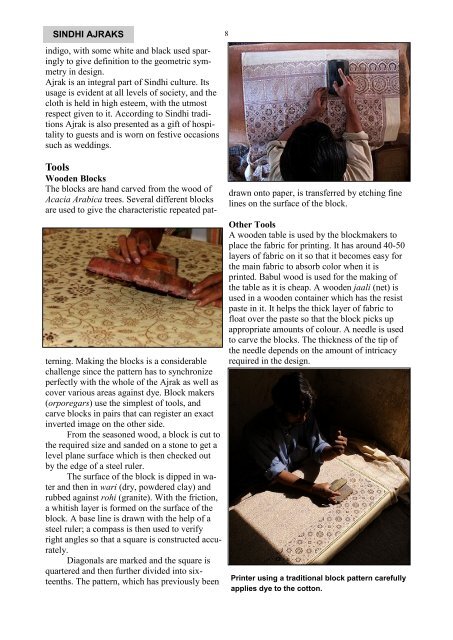download - OATG. Oxford Asian Textile Group
download - OATG. Oxford Asian Textile Group
download - OATG. Oxford Asian Textile Group
Create successful ePaper yourself
Turn your PDF publications into a flip-book with our unique Google optimized e-Paper software.
SINDHI AJRAKS<br />
indigo, with some white and black used sparingly<br />
to give definition to the geometric symmetry<br />
in design.<br />
Ajrak is an integral part of Sindhi culture. Its<br />
usage is evident at all levels of society, and the<br />
cloth is held in high esteem, with the utmost<br />
respect given to it. According to Sindhi traditions<br />
Ajrak is also presented as a gift of hospitality<br />
to guests and is worn on festive occasions<br />
such as weddings.<br />
8<br />
Tools<br />
Wooden Blocks<br />
The blocks are hand carved from the wood of<br />
Acacia Arabica trees. Several different blocks<br />
are used to give the characteristic repeated patterning.<br />
Making the blocks is a considerable<br />
challenge since the pattern has to synchronize<br />
perfectly with the whole of the Ajrak as well as<br />
cover various areas against dye. Block makers<br />
(orporegars) use the simplest of tools, and<br />
carve blocks in pairs that can register an exact<br />
inverted image on the other side.<br />
From the seasoned wood, a block is cut to<br />
the required size and sanded on a stone to get a<br />
level plane surface which is then checked out<br />
by the edge of a steel ruler.<br />
The surface of the block is dipped in water<br />
and then in wari (dry, powdered clay) and<br />
rubbed against rohi (granite). With the friction,<br />
a whitish layer is formed on the surface of the<br />
block. A base line is drawn with the help of a<br />
steel ruler; a compass is then used to verify<br />
right angles so that a square is constructed accurately.<br />
Diagonals are marked and the square is<br />
quartered and then further divided into sixteenths.<br />
The pattern, which has previously been<br />
drawn onto paper, is transferred by etching fine<br />
lines on the surface of the block.<br />
Other Tools<br />
A wooden table is used by the blockmakers to<br />
place the fabric for printing. It has around 40-50<br />
layers of fabric on it so that it becomes easy for<br />
the main fabric to absorb color when it is<br />
printed. Babul wood is used for the making of<br />
the table as it is cheap. A wooden jaali (net) is<br />
used in a wooden container which has the resist<br />
paste in it. It helps the thick layer of fabric to<br />
float over the paste so that the block picks up<br />
appropriate amounts of colour. A needle is used<br />
to carve the blocks. The thickness of the tip of<br />
the needle depends on the amount of intricacy<br />
required in the design.<br />
Printer using a traditional block pattern carefully<br />
applies dye to the cotton.

















